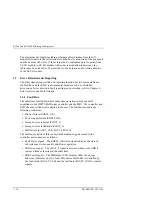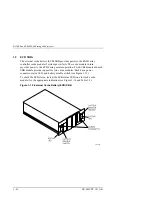
Chapter 1. Product Description
EK–SMCPP–UG. A01
1–17
Therefore, both the EMU and PVA monitor all of the power supplies (a
maximum of eight) to ensure that at least four are operational. An error condition
is indicated by one of the following conditions:
•
The +5 Vdc voltage drops to +4.7 Vdc
•
The +12 Vdc voltage drops to 11.4 Vdc
Another voltage essential for proper operation is the +5 Vdc termination power
(TERMPOWER) required for the SCSI bus on each of the six I/O modules. If
this voltage drops to +4.5 Vdc, an error condition exists.
As long as there are four operational supplies and TERMPOWER is correct, the
EMU and PVA generate the POK (power OK) signal. As long as POK is present
the controller can continue to transfer data providing there are no other error
conditions.
The loss of the POK signal for any reason causes the controller to reset and halt
all data transfers. All six buses remain quiesced (no data transfers occurring)
until the controller determines that power is correct. The controller does this by
checking the status of the POK signal. Until the POK reports that there are at
least four operational power supplies and that TERMPOWER is correct, the
controller, the cache memories, and all the devices remain passive. The EMU
and the PVA continue to monitor the system and report the error condition.
1.3.3.2 Master Enclosure Controlled Power Shutdown
The EMU can shut down the dc power in the master enclosure or the subsystem
when one of the following conditions occur:
•
The EMU determines an extreme over-temperature condition that requires
removing power from the subsystem
•
The user presses and holds down the PVA dc power switch until the EMU
initiates a controlled power shut down
NOTE
This is only true if both controllers have been
shut_down
When you initiate a controlled power shut down from the master enclosure PVA
the sequence of events is as follows:
1) The EMU changes its status to indicate that the dc power switch was pressed
2) The master EMU notifies the controller of the change in status.
3) When the controller is ready, it sends a controlled power shutdown
command to the master EMU.
4) A controlled power shut down is completed on all the subsystem cabinets.
















































